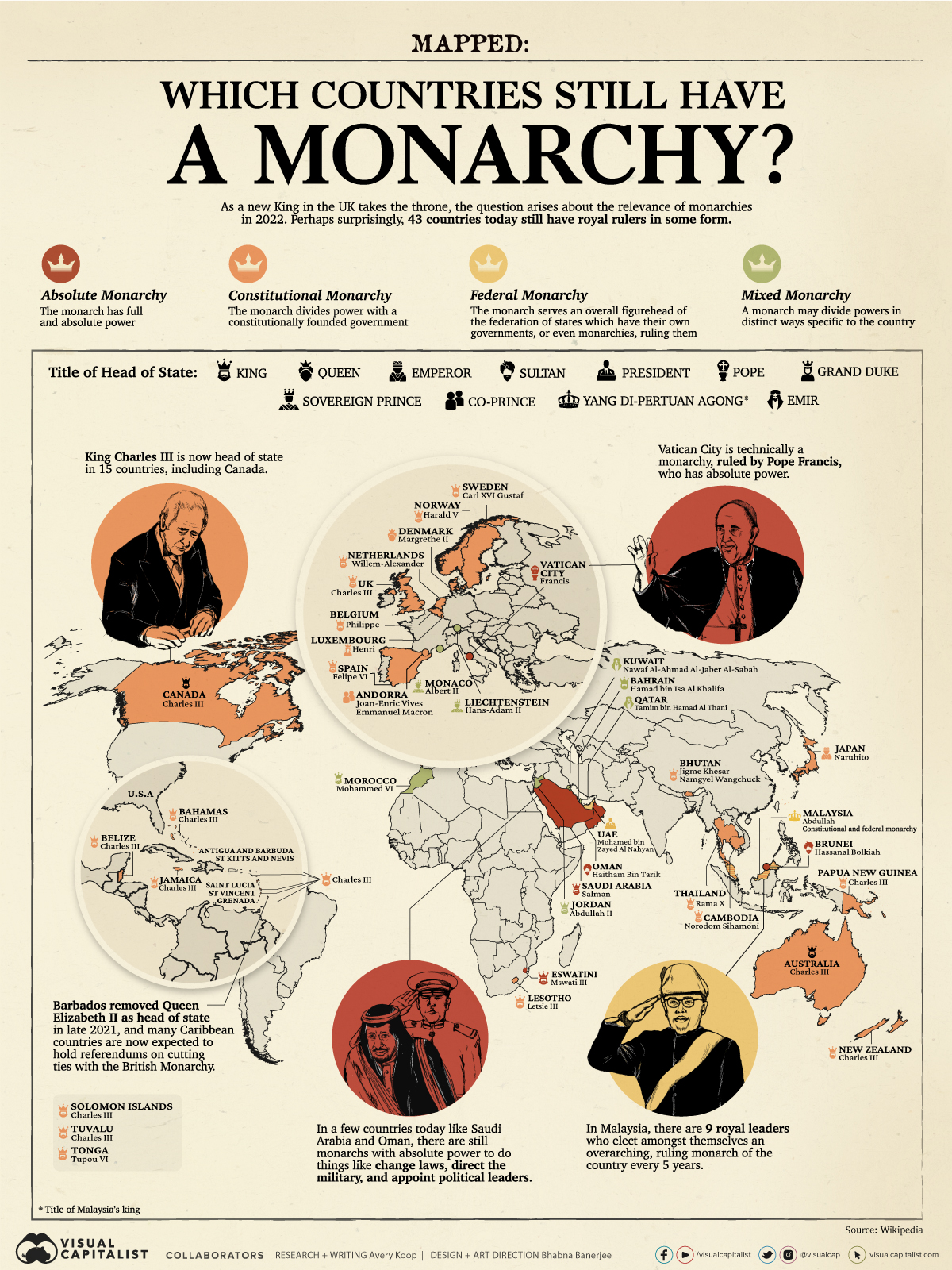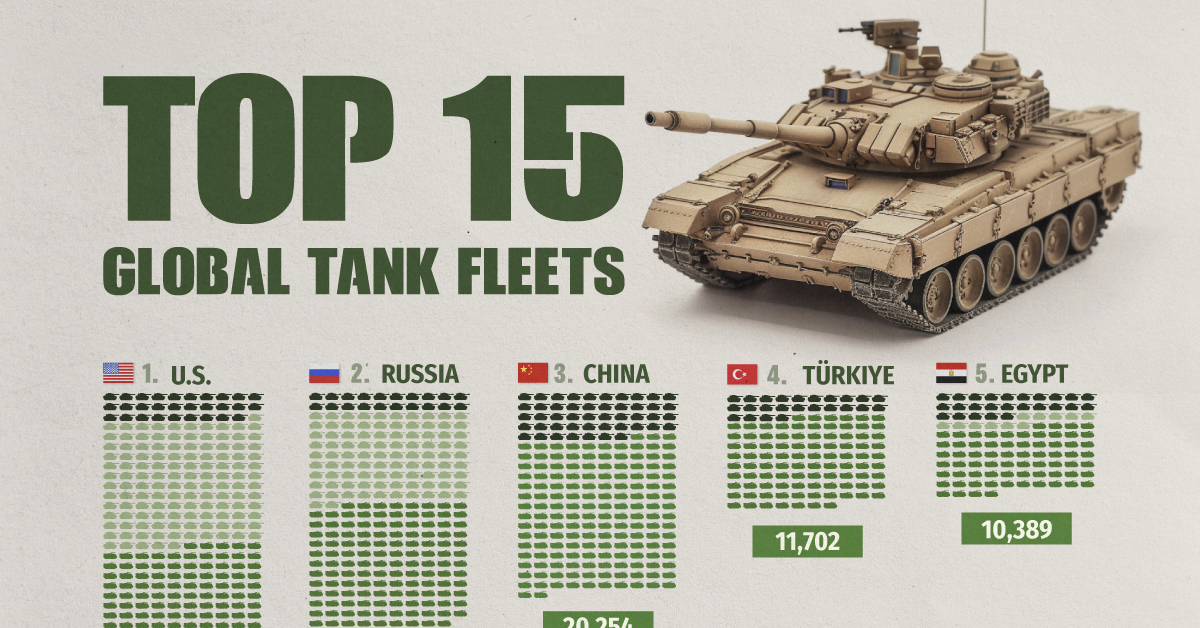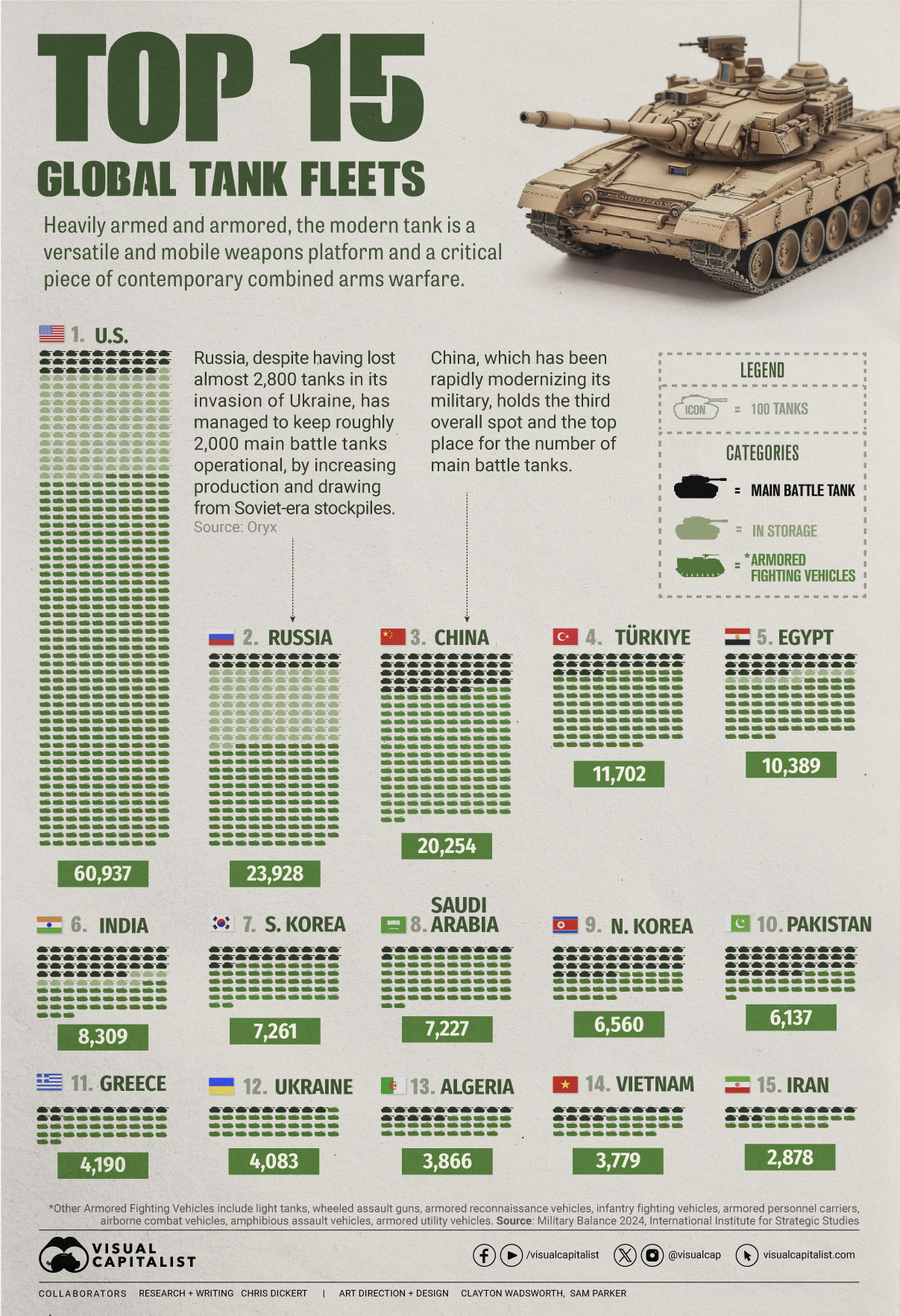Politics
Mapped: Which Countries Still Have a Monarchy?

Mapped: Which Countries Still Have a Monarchy?
In the wake of Queen Elizabeth II’s death, the question of monarchy is brought sharply into focus.
However, a surprising number of countries have ruling monarchs, and in this visual we break down the kinds of royal leadership across the 43 countries that still have them.
Types of Monarchies
A monarch in the simplest sense is a country’s king, queen, emir, or sultan, and so on. But before diving in, it’s important to break down the distinctions between the types of monarchies that exist today. Generally, there are four kinds:
① Constitutional Monarchy
The monarch divides power with a constitutionally founded government. In this situation, the monarch, while having ceremonial duties and certain responsibilities, does not have any political power. For example, the UK’s monarch must sign all laws to make them official, but has no power to change or reject new laws.
Here are some examples of countries with constitutional monarchies:
🇯🇵 Japan
🇬🇧 United Kingdom
🇩🇰 Denmark
② Absolute Monarchy
The monarch has full and absolute political power. They can amend, reject, or create laws, represent the country’s interests abroad, appoint political leaders, and so on.
Here are some examples of countries with absolute monarchies:
🇸🇿 Eswatini
🇸🇦 Saudi Arabia
🇻🇦 Vatican City
③ Federal Monarchy
The monarch serves an overall figurehead of the federation of states which have their own governments, or even monarchies, ruling them.
Here are some examples of countries with federal monarchies:
🇦🇪 UAE
🇲🇾 Malaysia
Malaysia is a unique form of federal monarchy. Every five years, each state’s royal leaders choose amongst themselves who will be the monarch, or the Yang di-Pertuan Agong, of Malaysia and the respective states. Furthermore, the monarchy is also constitutional, allowing a democratically elected body to govern.
④ Mixed Monarchy
This is a situation wherein an absolute monarch may divide powers in distinct ways specific to the country.
Here are some examples of countries with mixed monarchies:
🇯🇴 Jordan
🇱🇮 Liechtenstein
🇲🇦 Morocco
Interestingly, Liechtenstein is the only European monarchy that still practises strict agnatic primogeniture. Under agnatic primogeniture, the degree of kinship is determined by tracing descent from the nearest common ancestor through male ancestors.
Kings, Queens, Emperors, and Sultans Around the Globe
Now let’s break down the different monarchies country by country:
| Country | Type of Monarchy | Title of Head of State | Monarch | Title of Head of Government |
|---|---|---|---|---|
| 🇦🇩 Andorra | Constitutional | Co-Princes | Joan-Enric Vives, Emmanuel Macron | Prime Minister |
| 🇦🇬 Antigua and Barbuda | Constitutional | King | Charles III | Prime Minister |
| 🇦🇺 Australia | Constitutional | King | Charles III | Prime Minister |
| 🇧🇭 Bahrain | Mixed | King | Hamad bin Isa Al Khalifa | Prime Minister |
| 🇧🇪 Belgium | Constitutional | King | Philippe | Prime Minister |
| 🇧🇿 Belize | Constitutional | King | Charles III | Prime Minister |
| 🇧🇹 Bhutan | Constitutional | King | Jigme Khesar Namgyel Wangchuck | Prime Minister |
| 🇧🇳 Brunei Darussalam | Absolute | Sultan | Hassanal Bolkiah | Sultan |
| 🇰🇭 Cambodia | Constitutional | King | Norodom Sihamoni | Prime Minister |
| 🇨🇦 Canada | Constitutional | King | Charles III | Prime Minister |
| 🇩🇰 Denmark | Constitutional | Queen | Margrethe II | Prime Minister |
| 🇸🇿 Eswatini | Absolute | King | Mswati III | Prime Minister |
| 🇬🇩 Grenada | Constitutional | King | Charles III | Prime Minister |
| 🇯🇲 Jamaica | Constitutional | King | Charles III | Prime Minister |
| 🇯🇵 Japan | Constitutional | Emperor | Naruhito | Prime Minister |
| 🇯🇴 Jordan | Mixed | King | Abdullah II | Prime Minister |
| 🇰🇼 Kuwait | Mixed | Emir | Nawaf Al-Ahmad Al-Jaber Al-Sabah | Prime Minister |
| 🇱🇸 Lesotho | Constitutional | King | Letsie III | Prime Minister |
| 🇱🇮 Liechtenstein | Mixed | Sovereign Prince | Hans-Adam II | Prime Minister |
| 🇱🇺 Luxembourg | Constitutional | Grand Duke | Henri | Prime Minister |
| 🇲🇾 Malaysia | Constitutional & Federal | Yang di-Pertuan Agong | Abdullah | Prime Minister |
| 🇲🇨 Monaco | Mixed | Sovereign Prince | Albert II | Minister of State |
| 🇲🇦 Morocco | Mixed | King | Mohammed VI | Prime Minister |
| 🇳🇱 Netherlands | Constitutional | King | Willem-Alexander | Prime Minister |
| 🇳🇿 New Zealand | Constitutional | King | Charles III | Prime Minister |
| 🇳🇴 Norway | Constitutional | King | Harald V | Prime Minister |
| 🇴🇲 Oman | Absolute | Sultan | Haitham bin Tarik | Sultan |
| 🇵🇬 Papua New Guinea | Constitutional | King | Charles III | Prime Minister |
| 🇶🇦 Qatar | Mixed | Emir | Tamim bin Hamad Al Thani | Prime Minister |
| 🇰🇳 Saint Kitts and Nevis | Constitutional | King | Charles III | Prime Minister |
| 🇱🇨 Saint Lucia | Constitutional | King | Charles III | Prime Minister |
| 🇻🇨 Saint Vincent and the Grenadines | Constitutional | King | Charles III | Prime Minister |
| 🇸🇦 Saudi Arabia | Absolute | King | Salman | Prime Minister |
| 🇸🇧 Solomon Islands | Constitutional | King | Charles III | Prime Minister |
| 🇪🇸 Spain | Constitutional | King | Felipe VI | President of the Government |
| 🇸🇪 Sweden | Constitutional | King | Carl XVI Gustaf | Prime Minister |
| 🇹🇭 Thailand | Constitutional | King | Rama X | Prime Minister |
| 🇧🇸 The Bahamas | Constitutional | King | Charles III | Prime Minister |
| 🇹🇴 Tonga | Constitutional | King | Tupou VI | Prime Minister |
| 🇹🇻 Tuvalu | Constitutional | King | Charles III | Prime Minister |
| 🇦🇪 UAE | Federal | President | Mohamed bin Zayed Al Nahyan | Prime Minister |
| 🇬🇧 UK | Constitutional | King | Charles III | Prime Minister |
| 🇻🇦 Vatican City | Absolute | Pope | Francis | President of the Pontifical Commission |
Constitutional monarchies are undoubtedly the most popular form of royal leadership in the modern era, making up close to 70% of all monarchies. This situation allows for democratically elected governments to rule the country, while the monarch performs ceremonial duties.
Most monarchs are hereditary, inheriting their position by luck of their birth, but interestingly, French president, Emmanuel Macron, technically serves as a Co-Prince of Andorra.
Another unique case is the Vatican’s Pope Francis, who has absolute power in the small independent city—he gained his role thanks to an election process known as a papal conclave.
The Role of Monarchies
One of the most notable and famous ruling monarchies is the United Kingdom’s House of Windsor—also known as Queen Elizabeth II’s family. King Charles III has now ascended to the country’s throne, making him head of state in 15 nations total, including Canada, Australia, and New Zealand.
Many see the benefit in having a stable and consistent form of tradition and decorum at the country’s head of state.
“The Crown is an integral part of the institution of Parliament. The Queen [now King] plays a constitutional role in opening and dissolving Parliament and approving Bills before they become law.” – British Parliament
Japan’s royal family has been a prime example of stability, having reigned in the country for more than 2,600 years under the same hereditary line.
Critiques and the Future of Monarchy
Some claim, however, that there is no function of monarchy in the modern day, and complaints of monarchies’ immense wealth and power are rampant.
For example, according to the Dutch government, King Willem-Alexander’s budget for 2022, funded by the state and thus, taxpayers, comes out to more than €48 million.
Beyond tax dollars, with absolute monarchies there is typically a lack of political freedoms and certain rights. Saudi Arabia, for example, has no national elections. Rather its king, Salman bin Abdulaziz Al Saud, stays in power for life, appoints the cabinet himself, and passes laws by royal decree.
The death of Queen Elizabeth, though, may bring about change though for many of the world’s royally-governed. Since Barbados’ removal of her as head of state in 2021, six other Caribbean nations have expressed the desire to do the same, namely:
🇧🇿 Belize
🇧🇸 The Bahamas
🇯🇲 Jamaica
🇬🇩 Grenada
🇦🇬 Antigua and Barbuda
🇰🇳 St. Kitts and Nevis
The future of monarchy in the 21st century is certainly not a guarantee.
War
Visualized: Top 15 Global Tank Fleets
Heavily armed and armored, the modern tank is a versatile and mobile weapons platform, and a critical piece of contemporary warfare.

The Top 15 Global Tank Fleets
This was originally posted on our Voronoi app. Download the app for free on iOS or Android and discover incredible data-driven charts from a variety of trusted sources.
Heavily armed and armored, the modern tank is a versatile and mobile weapons platform, and a critical piece of contemporary warfare.
This visualization shows the top 15 global tank fleets, using data from the 2024 Military Balance report from the International Institute for Strategic Studies (IISS).
Let’s take an in-depth look at the top three fleets:
1. United States
As the world’s pre-eminent military power, it’s perhaps no surprise that the United States also has the largest tank fleet, by a wide margin.
In total, they have just over 45,000 armored fighting vehicles in operation, along with 2,640 main battle tanks (MBTs), and 12,800 vehicles in storage, of which 2,000 are main battle tanks.
| Category | Vehicles | Global rank |
|---|---|---|
| Main battle tanks | 2,640 | 4 |
| Armored reconnaissance | 1,745 | 1 |
| Infantry fighting vehicles | 3,262 | 3 |
| Armored personnel carriers | 10,644 | 1 |
| Amphibious assault vehicles | 1,401 | 1 |
| Armored utility vehicles | 28,445 | 1 |
| Storage | 12,800 | 1 |
| Total | 60,937 | 1 |
The U.S. is internalizing the lessons from the ongoing invasion of Ukraine, where Western-supplied anti-tank weapons and massed Ukrainian artillery have been cutting Russian tanks to pieces. As a result, the U.S. recently canceled an upgrade of the M1 Abrams in favor of a more ambitious upgrade.
Meanwhile, the U.S. is nervously eyeing a more confident China and a potential clash over Taiwan, where air and naval forces will be critical. However, a recent war game showed that Taiwanese mechanized ground forces, kitted out with American-made tanks and armored fighting vehicles, were critical in keeping the island autonomous.
2. Russia
According to Oryx, a Dutch open-source intelligence defense website, at time of writing, Russia has lost almost 2,800 main battle tanks since invading Ukraine. Considering that in the 2022 edition of the Military Balance, Russia was estimated to have 2,927 MBTs in operation, those are some hefty losses.
Russia has been able to maintain about 2,000 MBTs in the field, in part, by increasing domestic production. Many defense plants have been taken over by state-owned Rostec and now operate around the clock. Russia is also now spending a full third of their budget on defense, equivalent to about 7.5% of GDP.
At the same time, they’ve also been drawing down their Soviet-era stockpiles, which are modernized before being sent to the front. Just how long they can keep this up is an open question; their stockpiles are large, but not limitless. Here is what their storage levels look like:
| Category | 2023 | 2024 | YOY change |
|---|---|---|---|
| Main battle tanks | 5,000 | 4,000 | -20.0% |
| Armored reconnaissance | 1,000 | 100 | -90.0% |
| Infantry fighting vehicles | 4,000 | 2,800 | -30.0% |
| Armored personnel carriers | 6,000 | 2,300 | -61.7% |
| Total | 16,000 | 9,200 | -42.5% |
3. China
China holds the third overall spot and top place globally for the number of main battle tanks in operation. Untypically, the People’s Liberation Army has no armored vehicles in storage, which perhaps isn’t surprising when you consider that China has been rapidly modernizing its military and that stockpiles usually contain older models.
China also has one of the world’s largest fleets of armored fighting vehicles, second only to the United States. Breaking down that headline number, we can also see that they have the largest number of light tanks, wheeled guns, and infantry fighting vehicles.
| Category | Vehicles | Global rank |
|---|---|---|
| Main battle tanks | 4,700 | 1 |
| Light tanks | 1,330 | 1 |
| Wheeled guns | 1,250 | 1 |
| Infantry fighting vehicles | 8,200 | 1 |
| Armored personnel carriers | 3,604 | 5 |
| Airborne combat vehicles | 180 | 2 |
| Amphibious assault vehicles | 990 | 2 |
| Total | 20,254 | 3 |
This is equipment that would be integral if China were to make an attempt to reunify Taiwan with the mainland by force, where lightly armored mechanized units need to move with speed to occupy the island before Western allies can enter the fray. It’s worth noting that China also has one of the world’s largest fleets of amphibious assault vehicles.
End of the Tank?
Many commentators at the outset of Russia’s invasion of Ukraine, were quick to predict the end of the tank, however, to paraphrase Mark Twain, reports of the tank’s demise are greatly exaggerated.
With the U.S. and China both developing remote and autonomous armored vehicles, tanks could be quite different in the future, but there is nothing else that matches them for firepower, mobility, and survivability on the modern battlefield today.
-

 Mining2 weeks ago
Mining2 weeks agoCharted: The Value Gap Between the Gold Price and Gold Miners
-

 Real Estate1 week ago
Real Estate1 week agoRanked: The Most Valuable Housing Markets in America
-

 Business1 week ago
Business1 week agoCharted: Big Four Market Share by S&P 500 Audits
-

 AI1 week ago
AI1 week agoThe Stock Performance of U.S. Chipmakers So Far in 2024
-

 Misc1 week ago
Misc1 week agoAlmost Every EV Stock is Down After Q1 2024
-

 Money2 weeks ago
Money2 weeks agoWhere Does One U.S. Tax Dollar Go?
-

 Green2 weeks ago
Green2 weeks agoRanked: Top Countries by Total Forest Loss Since 2001
-

 Real Estate2 weeks ago
Real Estate2 weeks agoVisualizing America’s Shortage of Affordable Homes






